Voronezh, Voronezh, Russian Federation
Wood-plastic composite material is primarily a mixture of various natural (cellulose, lignin, etc.) and synthetic polymers (polyethylene, polypropylene, polyethylene terephthalate, etc.) In close interaction of molecules of different polymers behave in relation to each other in different ways: some are attracted, others repelled. Some polymers tend to join with each other in a chemical reaction, other chemically neutral. This phenomenon is called compatibility. The problem of compatibility of chemically different materials is well illustrated by a well-known example of the interaction of oil and water. Water droplets roll on the surface oil and oiled steel needle does not want to sink. In practice cannot be completely hydrophilic or hydrophobic substances, as well as oleophobic and oleophilic. Every substance has a greater or lesser degree of hydrophilicity, hydrophobicity, uliopilaste and oleophobicity. Chemistry gives you the opportunity to resolve the problem of adhesion of wood and synthetic polymers in a lot of ways, including modifying resin or (and) particles of wood (chemical, thermo-mechanical, mechanochemical, and even plasma irrad-iation processing). Modification of the basic raw materials are rather widely, since they have a good perspective. The article presents the research results of the bonding strength of the polyethylene terephthalate – wood and method of its improvement. To determine the adhesion strength in the system binder – filler were used the special samples for testing shear. The three selected wood species: pine, birch and oak. As the polymer component used PCM. The experiment was conducted on a tensile testing machine CDM a-10 with the use of special mounting of the sample. It is established that the adhesive bonding strength of the polyethylene terephthalate-wood is very low. Processing glyoxal filler enhances the adhesion strength of wood to the polymer. Depending on the breed and the direction of fibers fixed in improving adhesion 6-23 times.
adhesion, wood waste, improvement, composite.
1. Deryagin, B.V. Adgeziya [Tekst] / B. V. Deryagin, N.A. Krotova. - M., 1949. - 256 s.
2. Jankauskaite, V. Polyethylene terephthalate waste recycling and application possibilities: Areview [Text] / V. Jankauskaite, G. Macijauskas, R. Lygaitis. Medziagotyra. - 2012. - no. 14. - pp. 119-127.
3. Rahman, K.-S. Flat-pressed wood plastic composites from sawdust and recycled polyethylene terephthalate (PET): Physical and mechanical properties [Text] / K.-S. Rahman, M.N. Islam, M.M. Rahman, M.O. Hannan, R. Dungani, H.P.S.A. Khalil. SpringerPlus. - 2013. - no. 2. - pp. 1-7. DOI: https://doi.org/10.1186/2193-1801-2-629; EDN: https://elibrary.ru/UYTDBG
4. Porebska, R. Polymer matrix influence on stability of wood polymer composites [Text] / R. Porebska, A. Rybak, B. Kozub, R. Sekula. Polymers for Advanced Technologies. - 2015. - no. 26. - pp. 1076-1082.
5. Storodubtseva, T. N. Osobennosti matematicheskogo modelirovaniya drevesnogo poli-mer-peschanogo kompozita [Tekst] / T.N. Storodubtseva, A.A. Aksomitnyy. Lesotekhnicheskiy zhurnal. - 2014. - № 4. - S. 131-139. DOI: https://doi.org/10.12737/8462; EDN: https://elibrary.ru/TONCYH
6. Ruamcharoen, P. The chemical modification of waste PET and its application for a wood-polymer composite binder [Text]. P. Ruamcharoen, C.W. Phetphaisit, R. Bumee, J. Ruamcharoen, B. Niyomdecha, S. Nillawat. Advanced Materials Research. - 2012. - pp. 648-653.
7. Novyy spravochnik khimika i tekhnologa. Protsessy i apparaty khimicheskikh tekhnolo-giy [Tekst] / Pod red. G.M. Ostrovskogo. - Izd-vo ANO NPO «Professional», 2002. - T. 9. -10. - Ch. 1. - 848 s.
8. Vodyankina, O.V. Glioksal´ [Tekst] : monografiya / O.V. Vodyankina, L.N. Kurina, L.A. Petrov. - Moskva, 2007. - 247 s.
9. Storodubtseva, T.N. Vliyanie vodopogloshcheniya na svoystva drevesiny v polimertse-mentnom kompozitsionnom materiale [Tekst] / T.N. Storodubtseva, A.I. Tomilin. Lesotekh-nicheskiy zhurnal. - 2014. - T. 4. - № 2 (14). - S. 177-182
10. Pashchenko, A.A. Vyazhushchie materialy [Tekst] / A.A. Pashchenko, V.P. Serbin, E.A. Starchevskaya. - Izdatel´skoe ob´´edinenie.: «Vysshaya shkola», 1975. - 444 s.












